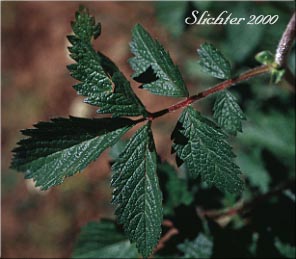Photo above of Potentilla glandulosa var. intermedia from alongside Oregon Highway 204 near Tollgate, Or.......July 6, 1999.
Photo above of Potentilla glandulosa var. intermedia from alongside Oregon Highway 204 near Tollgate, Or.......July 6, 1999.
 Photo at right
of the leaf of Potentilla glandulosa var. intermedia from Buckhorn C.G. in the Wallowa-Whitman N.F........July 7,
1999.
Photo at right
of the leaf of Potentilla glandulosa var. intermedia from Buckhorn C.G. in the Wallowa-Whitman N.F........July 7,
1999.
As its name implies, sticky cinquefoil has glandular herbage with a sticky texture. It is a perennial with one to several spreading to erect stems from 15-70 cm high. The stems are typically unbranched below the inflorescence. The leaves are pinnately compound with 5-9 leaflets, all the lower ones opposite on the midvein and the terminal one single. The leaflets are 1-3 cm long and obovate or oblong-obovate in shape with single- or double-toothed margins. The stem leaves are much smaller and reduced in size upward on the stems.
The inflorescence is a few-flowered, open to dense cyme. The branches of the cyme vary from erect to spreading. A number of reduced to large, leaf-like bracts are found within the cyme. The petals vary from yellow-white to a deep yellow. The stamens usually number 25-40 and the pistils are numerous. Depending on the variety, the petals vary from much shorter than the sepals to much longer than the sepals.
1. Variety reflexa: Petals about 1 mm shorter than the sepals. Petals spreading to reflexed. Inflorescence often with reduced, nonleafy bracts. From Wasco County, Oregon sporadically south along the east side of the Cascades to northern California, where more common through the Sierra Nevada to southern California.
2. Variety glandulosa: Petals about equal in length to the sepals. Petals often ascending or erect. Inflorescence with leaf-like bracts. From southern British Columbia south to Baja California and east to eastern Washington, western Idaho, and northeastern Oregon.
3. Variety intermedia: Petals range from 0.5-1.5 mm longer than the sepals. Petals lemon to butter-yellow. Plants from 30-60 cm tall. Inflorescence with leafy bracts and few, usually erect branches. From the eastern foothills of the Cascades of Washington east (sporadically) to Idaho, northeastern Oregon, and Montana, Colorado, and northern Utah where it is more common.
4. Variety pseudorupestris: petals range from 0.5-1.5 mm longer than the sepals. Petals nearly white, to cream or light canary yellow. Plants often less than 3 dm tall. The inflorescence is often more open but seldom with leaf-like bracts. About the same range as variety intermedia
Graceful cinquefoil may be found on moist soils in grasslands, meadows, and in the sagebrush desert, or in moist, open woodlands.
Sticky cinquefoil may be found from southwestern British Columbia south to northern Baja California, and eastward to Southwestern Alberta. There it may be found southward through the Rockies to Utah and Arizona.